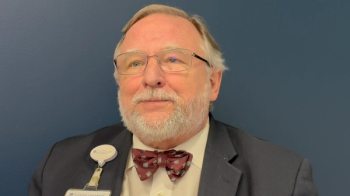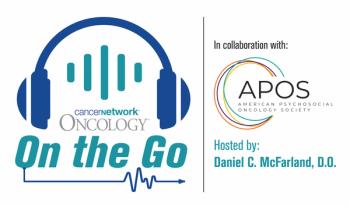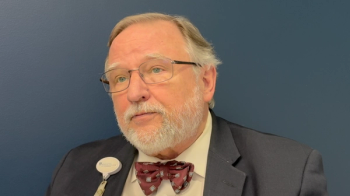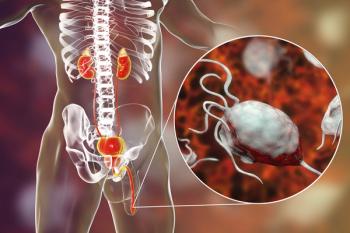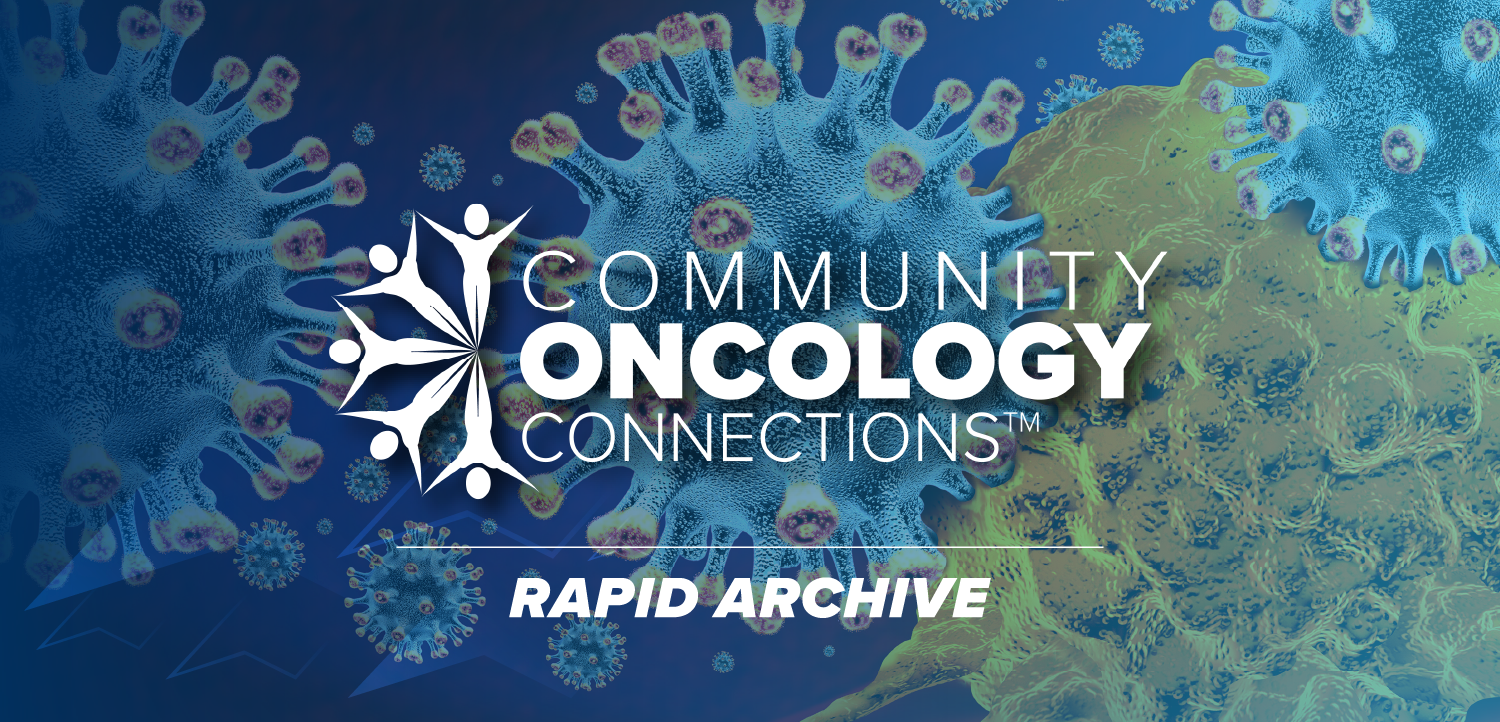
Considerations for CAR T Use Across Large B-Cell Lymphoma Variants
Jose Sandoval Sus, MD, discussed the “revolution” that CAR T-cell therapies have facilitated for patients with large B-cell lymphomas.
In a conversation with CancerNetwork® at the 2025 National Immune Cell Effector Therapy Conference, Jose Sandoval Sus, MD, assistant member of the Malignant Hematology and Cellular Therapy Program at Moffitt Cancer Center, discussed the use considerations for the use of numerous emergent chimeric antigen receptor (CAR) T-cell therapies across a broad spectrum of large B-cell lymphoma variants.1
He began by highlighting the focus of the presentation he gave at the conference, which he explained recapped the emergence of anti-CD19 CAR T-cell therapies in B-cell non-Hodgkin lymphoma variants, describing it as a “revolution.” Sandoval Sus further highlighted standard treatments for patients with large B-cell lymphomas, disaggregated by disease variant, risk assessment, and line of therapy.
Next, Sandoval Sus touched upon CAR T-cell therapies currently undergoing investigation and showing promise in large B-cell lymphoma, which include agents such as rapcabtagene autoleucel (YTB323), in reducing vein-to-vein time among patients undergoing leukapheresis during CAR T-cell collection and dual-targeting CAR T therapies. He concluded by discussing considerations for expanding access to CAR T-cell therapies, including optimizing their use outside of academic centers and increasing referrals for CAR T use in the community setting.
CancerNetwork: What was the focus of your presentation on CAR T-cell therapy developments in lymphoma?
Sandoval Sus: My topic [was] a recap of the revolution that anti-CD19 CAR T-cell therapies have brought to the field of B-cell non-Hodgkin lymphoma. [In] large B-cell lymphoma, follicular lymphoma, and a little snippet of a marginal zone lymphoma [MZL], CAR T-cell therapy has been incredibly revolutionary for patients with these diseases. Before, with patients who had relapsed/refractory large B-cell lymphoma, as an example, the [median] survival of those patients would not be more than 6 months.
Nowadays, at 5 years, we are seeing that [more than] 40% of those patients are alive and about 30% are alive without their disease coming back. It has been a real revolution. For the other indolent lymphomas, like follicular lymphoma and [MZL], we [have] also seen promising outcomes with these constructs. I [gave a] recap of what we have learned up until now with some updated information about [CAR T-cell therapies in B-cell non-Hodgkin lymphoma] up to 2025.
What do current standard treatment options look like for these lymphoma patient populations, and what would you say are some strengths and limitations associated with these strategies?
Sandoval Sus: For diffuse large B-cell lymphoma, we call it large B-cell lymphoma because we understand that diffuse large B-cell lymphoma is not just one disease. It is one diagnosis, but it can behave in multiple ways. [When] talking about diffuse large B-cell lymphoma not otherwise specified or high-grade B-cell lymphoma with high-risk features—for example, rearrangements in MEK and BCL2—I firmly believe that for patients who have a primary refractory disease, meaning that they did not have a response through the first chemoimmunotherapy regimen, or the patients with an early relapse, meaning that the disease [recurs] in the first 12 months, CAR T-cell therapies in the US should be the standard of care.
We have 2 constructs that have demonstrated [an improvement in OS]. One of them demonstrated improvement in overall survival in second-line therapy that is called axicabtagene ciloleucel [Yescarta], otherwise [called] axi-cel. We have another one that is trending that way and has remarkable outcomes as well, which is called lisocabtagene maraleucel, [also known] as liso-cel.
In the third line, I believe that every patient should be offered treatment with anti-CD19 CAR T-cell therapy. In that setting, we have 3 constructs. I already talked about axi-cel and liso-cel, which, at 5 years, [showed] around 35% to 40% of patients were alive and some of them without [any] disease whatsoever. There is another compound that is called tisagenlecleucel [Kymriah], otherwise known as [tisa-cel], approved for relapsed/refractory large B-cell lymphoma after 2 lines of therapy or more.2 In that setting, it shows promising progression-free survival [and] overall survival outcomes in general in patients with large B-cell lymphoma.
In patients [with large B-cell lymphoma], there are a couple of limitations that we need to be aware of. Although these agents are incredibly active, we know that it is limited to centers that specialize in cellular therapy. It used to be that there were fewer than 100 centers across the US, but more institutions are [becoming] specialized in this area of cellular therapy. We still have a long way to go and a long way to providing more access to these lifesaving therapies to our patients.
Another important limitation is what we call financial toxicity. They're [quite] expensive agents, and we need to find a way not only to improve access but to make these medications less costly in the long run. I believe that there’s a potential for these types of therapies to be taken [before second line, in earlier lines, and] maybe on the front line. We have at least 2 trials that I know of that are evaluating these agents in the front line for high-risk patients with large B-cell lymphoma. You can imagine that it is going to expand the potential candidates for these treatments if these [outcomes] are positive.
We need to not only improve access but also decrease the financial toxicity [associated with] these medications. That’s an ongoing challenge that [many] of us in the fields are trying to find solutions [for, including] working with our colleagues in pharmaceuticals.
What CAR T-cell therapies are currently under investigation that show the most promise in treating patients with lymphoma and other diseases, and what data support their use?
Sandoval Sus: There are [many] questions that we need to tackle. One of them is [decreasing] vein-to-vein time. When we [perform leukapheresis for] the patient, we collect their cells, and when the product is ready to be infused for the patient––one of them is a compound called [rapcabtagene autoleucel]––the vein-to-vein time [may] be less than 7 days, [perhaps] around 3 to 5 days, incredibly fast. In the early reports of a phase 2 trial [NCT03960840], the overall response rates, complete response [rates], and at least 6 months of progression-free survival look comparable to other CD19-targeting CAR T-cell therapy.3 More to see about that, and that looks [quite] promising.
[The other question is] how we can overcome the mechanisms of resistance of these cells. In the summer conferences, several talks were intriguing and quite promising about some agents that have dual-targeting capabilities. Right now, like the name of the CAR T-cells says––anti-CD19––we are only targeting the CD19 antigen right now. The next wave of these CAR T cells is targeting 2 antigens. One of them is CD19, and the other one is ECD20.
You can [dual target] in 2 different ways. There's a construct from [Kite Pharma], for example, that is called bicistronic, which in the same cell has 2 different CARs. One for CD19, and it keeps the construct of CD19 with the costimulatory molecule, CD28, and they have a different construct on the same cell driving CD20 with a costimulatory 4-1BB molecule. That's one of them.
There are 2 other compounds that I can think about, one from [Johnson & Johnson] and another one from Miltenyi Biotec; these 2 compounds have differences between how they were manufactured, how fast [they are] manufactured, and how one of them is a fresh product vs another one [being] cryopreserved. [They] have the same mechanism of action, the same concept of the construct. That is what we call a tandem CAR T. In the same construct, they have expression of both [proteins]. They can target with the same construct, both CD19 and CD20. That's another wave of development. Those constructs are a bit more advanced than others.
There are other concepts that are a bit advanced in development targeting both antigens, CD19 and CD20, by enriching the product for what we call memory T cells or naive T cells that have been associated with better clinical responses. There's a company that is doing that as well.
[Finally,] targeting other B-cell lymphoma [variants] that have been left behind, unfortunately, because we need to devise better strategies to tackle them. For example, in Hodgkin lymphoma or our T-cell lymphomas, there's an interesting concept right now of an allogeneic natural killer [NK] cell group with a tetravalent bispecific antibody. [This agent targets] CD16 and CD30, which is expressed on Hodgkin lymphomas and some of our T-cell lymphomas. The data [are premature] but show remarkable tolerability and some early efficacy. That is quite intriguing, and we are looking forward to that. There are [many] things that we could say, also [highlight] allogeneic CAR T cells are important [in decreasing] vein-to-vein timing, [and there] already have been some early results [published] in that regard.
How can the field expand access to CAR T-cell therapy for patients with these malignancies?
Sandoval Sus: We have several strategies that [we could] all work on as the field moves forward with [CAR T-cell therapy]. Some of the constructs that we have available right now are quite effective, and some of them we are learning have [fewer] toxicities, especially treatment-related [adverse] effects of interest, such as cytokine release syndrome, [immune effector cell–associated neurotoxicity syndrome], and [others]. I am talking about both [toxicities] because those are usually the acute toxicities that sometimes limit the generalizability of these products in the community.
Some of these new constructs we might be able to use with an appropriate setup and the appropriate place to take them, more from the inpatient setting to the outpatient setting. Maybe patients can return [sooner] to their oncologist and to the community to be followed there a bit closer. One of the strategies is working more toward taking these CAR T-cell therapies in a safe way for the right patients at the right time to the outpatient setting and working as we have been doing closely but doing it [to better accommodate] our colleagues in the community.
The other thing is identifying [which] patients are at higher risk for worse toxicities and working on new strategies to mitigate [them]. We have tried different things—prophylactic steroids, prophylactic tocilizumab [Actemra], another anti–IL-1 antibody called anakinra [Kineret]—and recently, we also tried other [agents] as prophylaxis to decrease the toxicity of these regimens: for example, JAK inhibitors. That is another strategy working in prophylactic or preventive measures to decrease the toxicity of the CAR T cells.
Another one [that] is also important for us to talk about [with] the patients and their caregivers, to take home the message to [community oncologists] or the colleagues of a loved one, [is] to offer CAR T cells. It is rare for us to see [this] in the community, but [they should] at least to have the opportunity to refer patients early on for a consultation on CAR T-cell therapy [so] that they can determine whether they are going to need this. I believe that a patient with an early relapse of large B-cell lymphoma should get a consultation at a CAR T-cell service sooner rather than later. These patients who are at high risk for early death from their disease or patients with mantle cell lymphoma, especially with high-risk features, should also [receive] an early consultation, [preferably] at their first relapse. Early consultation will expand access for curative therapies like CAR T cells.
References
- Sandoval Sus J. Revolutionizing lymphoma treatment: the latest breakthrough in CAR-T therapy. Presented at: 2025 National Immune Cell Effector Therapy Conference; July 26, 2025; Orlando, FL.
- FDA approves tisagenlecleucel for adults with relapsed or refractory large B-cell lymphoma. FDA. May 1, 2018. Accessed August 1, 2025. https://tinyurl.com/5exzpw6p
- Riedell PA, Kwon M, Finn IW, et al. Rapcabtagene autoleucel (YTB323) in patients (pts) with relapsed/refractory diffuse large B-cell lymphoma (R/R DLBCL): phase II trial clinical update. Blood. 2024;144(suppl 1):67. doi:10.1182/blood-2024-204264
Newsletter
Stay up to date on recent advances in the multidisciplinary approach to cancer.


